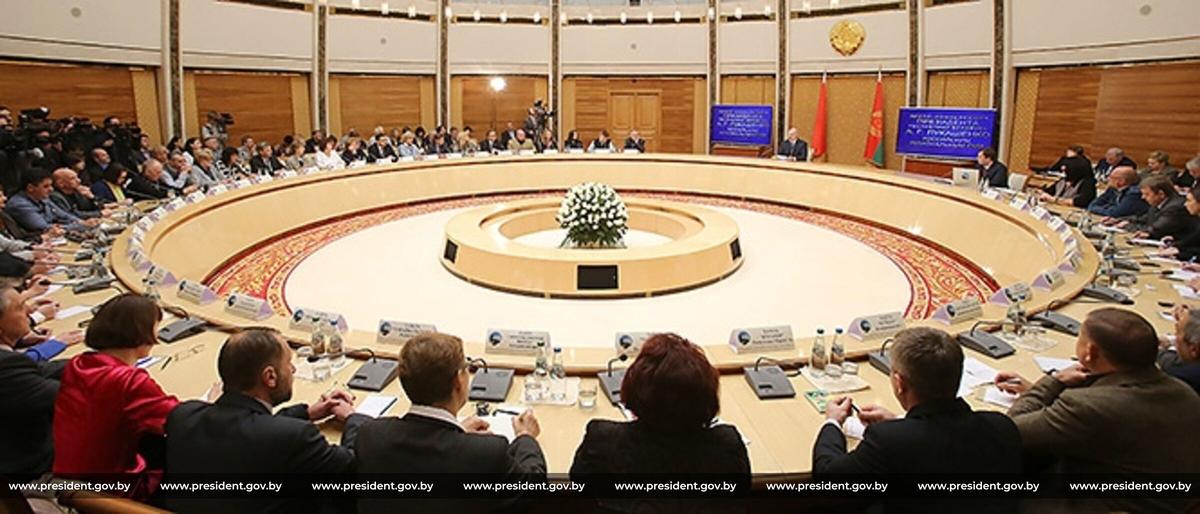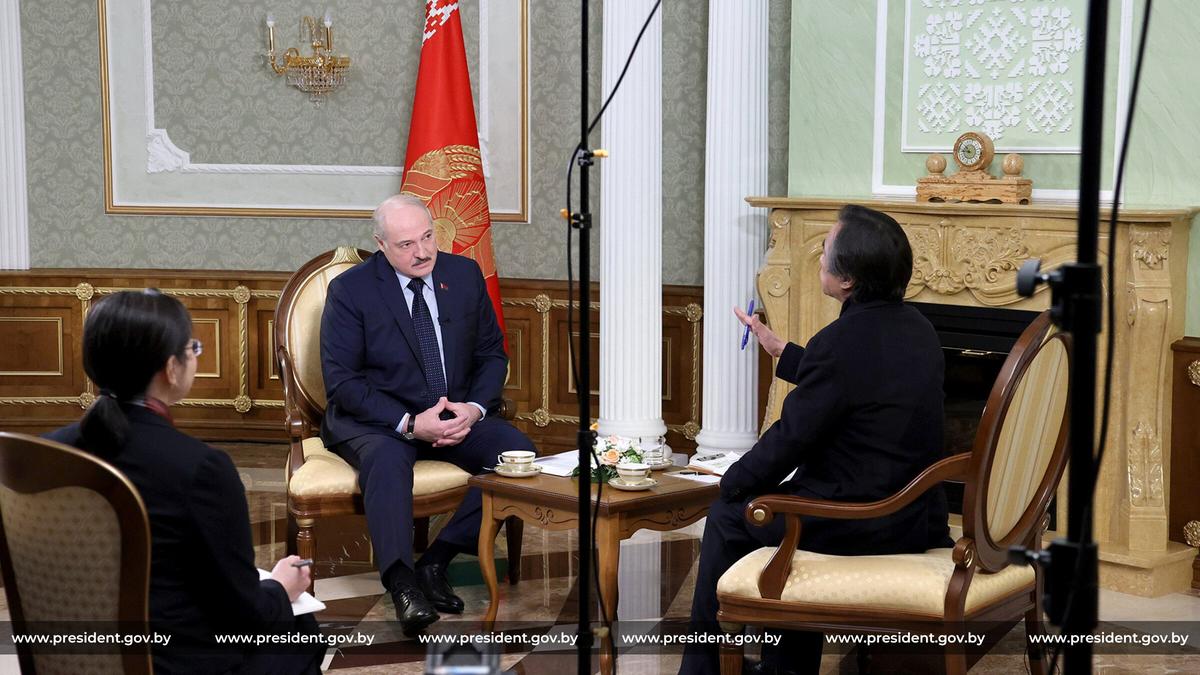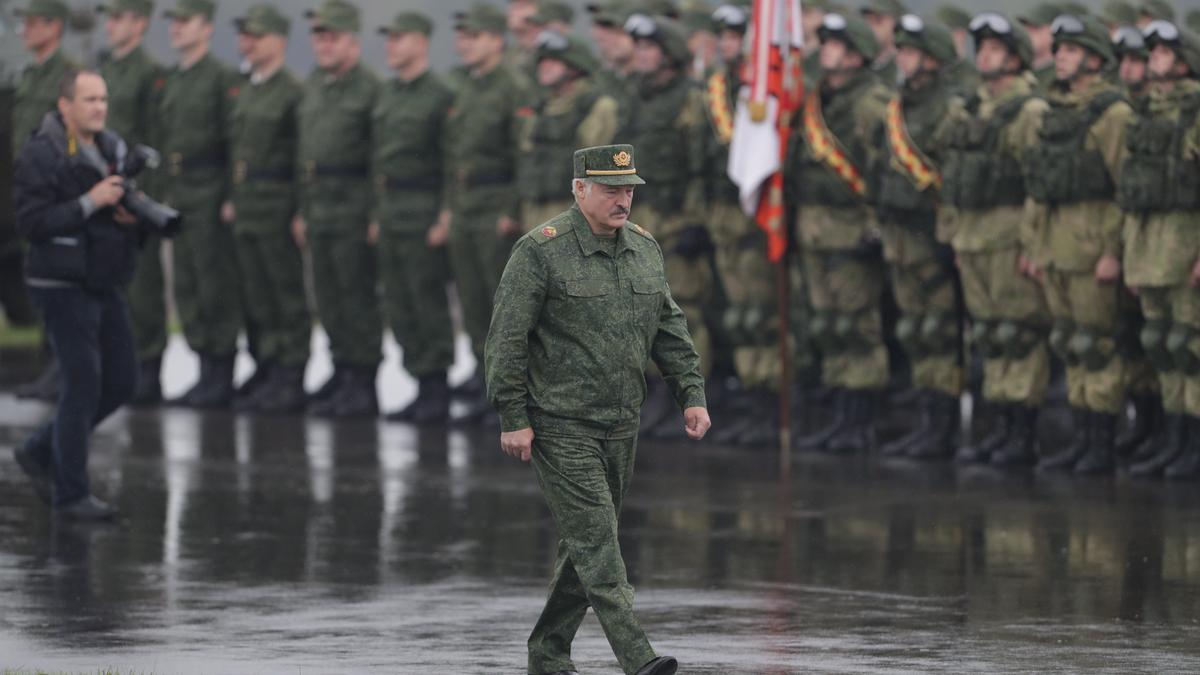Whether there are Russian tactical nuclear weapons in Belarus now is a big question. As early as on 25 May, Alyaksandar Lukashenka said on TV that the transportation of nuclear ammunition had already started. On 16 June, Vladimir Putin stated that the first batch of nuclear devices had already been deployed in Belarus, “and the mission will be complete before the end of the year” . However, Ukraine’s military intelligence chief Kyrylo Budanov said on 20 June that zero warheads had arrived in Belarus to that day.
Everyone knows how trustworthy Putin and Lukashenka are, so Budanov is most likely right, and the two dictators have only been using the nukes as a ploy to manipulate the media. But this doesn’t mean that the warheads won’t arrive in Belarus tomorrow. And we can’t rule out that the same warheads might be used to target Europe the day after that.
‘May our foes tremble in fear’
There are few things that rouse Lukashenka as much as nuclear weapons do. In an interview for Russian propagandist Olga Skabeeva, he stated that Belarus has plenty of space for nuclear missiles and atomic bombs. And he added with a pinch of delight: “The bomb is three times as mighty as the Hiroshima and Nagasaki one. It can kill, I don’t know, up to a million people instantly.”
He also said that he demanded rather than asked for the nuclear weapons as he spoke to Putin. Lukashenka added that there would be no issue with approving a potential strike: “What kind of problem is that to agree on some strike? This isn’t even a question. There is nothing to argue about. We have already agreed. May our foes tremble in fear.”
“Demands rather than requests” are quite unlikely. In this alliance, Lukashenka isn’t in a position to demand things. But his dreams of having the weapon and his requests for it are, without a doubt, a reality.
Three months before the start of the Ukraine war, Lukashenka spoke to [Russian propagandist] Dmitry Kiselyov and said that should NATO decide to deploy warheads in Eastern Europe, like in Poland, he would ask Vladimir Putin to return nuclear weapons to Belarus.
Years back, in 2010 and 2014, he referred to the removal of nuclear weapons from his country as “a most terrible mistake”. However, he’s been changing his explanations over time, a thing he does quite often. In 2010, he claimed to have signed a nuclear weapons withdrawal treaty himself, while in 2014 he said he only obeyed what the “nationalists” had signed.

Alyaksandar Lukashenka’s press conference. Photo: president.gov.by
‘Lukashenka cried his heart out’
Andrei Sannikau, the former Deputy Foreign Minister of Belarus who led the Belarusian delegation during the nuclear disarmament negotiations, has told Novaya-Europe the details of how it really happened and who signed the document:
“Obviously, as the Soviet Union collapsed, it was an urgent question: what do we do with the nuclear weapons? The US was scared to the bone that there might be several new nuclear countries instead of just one, so they decided to make an ‘under-the-table’ agreement with Russia at first. We, Belarus and Ukraine, insisted that a negotiation on legal succession should be held. We made some preliminary statements that we had no intention to become nuclear countries, but we said that no negotiation regarding what’s going to happen on our territory is possible without our participation.
The Intermediate-Range Nuclear Forces Treaty had already been fully implemented by 1991 in terms of the destroyed missiles, but obligations to inspect each other’s locations of former deployment of those missiles remained. The only active treaty was the START treaty. We had 81 warheads on our territory: 72 of those were mounted on missiles, and 9 more were stored elsewhere.
The situation was easier for Belarus than for Ukraine since we only had mobile missiles but had zero launching silos. All the missiles were Topols: RS-12M Topol is a mobile intercontinental strategic missile with a nuclear warhead. This is why we, unlike the Ukrainians, didn’t have to worry about destroying the missiles, transporting the warheads, and getting rid of the nuclear fuel and the silos where the missiles were stored. And when the negotiations started, not only Russia, but also the States tried to oppose us: they wanted to end this whole thing as soon as possible with the least losses for themselves, not realising that it is very important for young states to build up their independence, and therefore it is impossible to solve important issues concerning these states without them participating.
The negotiation took a lot of time. The issues at hand were not only the nuclear withdrawal, but also the potential addition of Ukraine, Kazakhstan, and Belarus to the Treaty on the Non-Proliferation of Nuclear Weapons. First, the Lisbon Protocol was signed in 1992, and the Belarusian signature was from Piatro Kravchanka, the country’s Foreign Minister at that time, and then the infamous Budapest Memorandum was signed by Lukashenka in December 1994. This agreement stated that the UK, the US, and Russia were obliged to protect our sovereignty.
Lukashenka tried to delay the withdrawal of missiles before he received a wake-up call from Moscow. The last missile was transported in 1996, and Lukashenka later stated that he had cried his heart out as the missile left Belarusian territory. Now he’s got what he desired. <…>
We never fully satisfied the START treaty as launching sites for mobile missiles remained in Belarus. To put it simply, this is how the launch goes: a truck delivers a missile, and then puts it in a vertical position. But you can’t just place it on tender ground. So, the launching sites are thick reinforced concrete platforms to place the missile on before launch. We were obliged to destroy those platforms. I started the negotiation with the US, and here’s what I said to them: give us money and help us with the technology. They said it wasn’t a problem. The Americans had this perforation technology where they calculated everything thoroughly, rigged the thing with explosives, and blew it up. The forest around it remained intact, and the platform simply vanished.
But then Lukashenka took charge and started to act stubborn. He said there was no need to negotiate the thing with the Americans as there was Russia to cooperate with. So, one day the Russians arrived and blew up one of the platforms. They destroyed half the forest nearby, and the slab stood on its end; it remains this way somewhere in the woods. When Lukashenka says “we preserved everything”, he must be talking about those concrete platforms in the middle of nowhere that nobody needs now since the new launch technology for the very same Topol missiles does not require these sites. I mean, nobody actually needs those, but Lukashenka reckons those are strategic facilities.”
A farewell to arms
The last Topol missile left Belarusian territory on 27 November 1996 as it was removed from the Yatsuki site in the Hrodna region. The military arranged a farewell ceremony, but Lukashenko never arrived to wave the missile goodbye. Apart from the sites that nobody needs, Belarus also has enriched uranium in Sosny near Minsk where a research reactor is owned by the Institute of Energy Issues.
How much uranium is still left in Belarus is anybody’s guess. When Lukashenka spoke about the “terrible mistake” of abandoning nuclear weapons to Russia in 2010, he mentioned that Belarus had hundreds of kilos of uranium. But “hundreds” in the plural might mean anything, be it two hundred or twenty hundred. “I’ve been told for years to get rid of this uranium,” Lukashenka said. “Option one is the US, and we may have some compensation for this, option two is Russia. What I tell them is: ‘First, why do you dictate things to us, it’s our commodity, and we store it under IAEA’s control. We’re not going to produce some ‘dirty bombs’ or sell it to anyone. We use this uranium for research purposes. I’m being put against the wall now, a knife to my throat: give it away. And I say: we abandoned nuclear weapons back in the day, and what did we get in return?”
Nothing for now. Arms rattling, be it real or made-up arms, always leads to a breakdown of connections and dissolution of agreements backed by the most respectable signatories.
The perfect example is the Budapest Memorandum. Strictly speaking, it is three separate documents: on Ukraine, Belarus, and Kazakhstan, rather than one single paper. All three were signed on 5 December 1994. In the Budapest Memorandum, the participating parties, namely the United States, the United Kingdom, and Russia, took obligations to respect the independence and sovereignty of each of the three new countries, and not to allow encroachments on their territorial integrity.
As for the Ukraine agreement, France and China sent in their notes supporting the memorandum, joining the signatories: Russia, the US, and the UK. Thus, Ukraine is the only one of the three post-Soviet countries that gave away nuclear weapons to assure the support of all five permanent members of the UN Security Council.
None of them, however, even called in a consultation in 2014. The Budapest Memorandum has been knocked out of reckoning without any prior arrangement, and nobody cares to mention it now.
Support independent journalism
Not a farewell but a ‘see you later’
On 17 February 2022, one week before the war, Alyaksandar Lukashenka spoke at the Union Resolve 2022 military exercise and warned the West that he would be an eternal president “if Belarus remains at gunpoint” and that he would deploy “not just nuclear weapons, but also ‘ultra nuclear’ ones”. A week later, missiles were launched at Kyiv from Belarusian territory.
On 26 February 2022, Lukashenka spoke on the phone with French President Emmanuel Macron and called the talks about the potential deployment of nuclear weapons in Belarus “fake news”.

Alyaksandar Lukashenka during an interview with Japan’s TBS channel. Photo: president.gov.by
On 17 March 2022, in an interview with the Japanese TV channel TBS, Lukashenka stated that he did not plan to “deploy nuclear weapons here [in Belarus], produce nuclear weapons here, create and use these nuclear weapons against anyone. This has never been in the plans of the Belarusian leadership nor in my plans.” On 20 March, Ukraine’s General Staff recorded signs indicating that the armed forces of Belarus were preparing for a direct invasion of Ukrainian territory.
On 5 May 2022, Lukashenka told Associated Press that the use of nuclear weapons was absolutely unacceptable. On 10 May, he held a meeting with the military and said that it would not be possible to defeat NATO, but “to inflict damage, especially on those territories we will be attacked from — we have weapons for this.”
All the contradictions between the words and actions of Lukashenka, as well as between his own statements, ceased to exist last summer.
On 2 June, during a public speech, he stated that he was entitled to “request and demand” nuclear weapons from Putin. Then there was a speech in Astana and remarks during meetings with Vladimir Putin. In his speeches, Lukashenka was as certain as ever that a country that possesses nuclear weapons cannot be defeated. As he spoke, it was almost as if he was becoming physically bigger and shivering from excitement. And here we are: the weapons are either already in Belarus or on the way there. Welcome home. Belarus has been without the missiles for 25 years.
Many make this big mistake now, going into theoretical reasoning on the difference between the tactical and strategic nuclear weapons. This is completely unimportant right now. A tactical weapon is but a nominal notion. The difference is in its power only. But in principle, any nuclear weapon is strategic, no matter how it is classified, for one simple reason: if used, it immediately changes the nature of the war and turns it into a nuclear one. NATO member countries will have to retaliate right away. They have scenarios of responding to nuclear strikes by also using nuclear weapons, obviously. The first strike will open Pandora’s box. But we can say it’s already been open.
Join us in rebuilding Novaya Gazeta Europe
The Russian government has banned independent media. We were forced to leave our country in order to keep doing our job, telling our readers about what is going on Russia, Ukraine and Europe.
We will continue fighting against warfare and dictatorship. We believe that freedom of speech is the most efficient antidote against tyranny. Support us financially to help us fight for peace and freedom.
By clicking the Support button, you agree to the processing of your personal data.
To cancel a regular donation, please write to [email protected]

